The Journey Into Imagination attraction has gone through many changes since it opened at EPCOT on March 5, 1983. In honor of its 40th anniversary (and the 40th birthday of the lovable dragon Figment), let’s take a look at the history of this beloved attraction and its characters.
Development

Our story of the imagination ride and its original cast starts with a little-known attraction that was worked on for Disneyland’s proposed Discovery Bay project in the 1970s, referred to as a Victorian moving theater ride. The attraction would have dealt with science and the hosts would be a scientist called Professor Marvel (who happened to breed dragons) and his companion, a little green dragon. As with all unused Imagineering ideas, these concepts sat dormant until Kodak and Walt Disney Imagineering met to begin discussing concepts for their attraction that would inhabit the space next to the Magic Eye Theater at EPCOT Center.

When Kodak was introduced to the scientist and the dragon, they felt they had found the right cast of characters, except thought a green dragon was too reminiscent of the Fuji colors, Kodak’s largest competitor. With a little bit of work, the scientist became the Dreamfinder — a man who collects ideas to spark the imagination — and the dragon become our favorite little purple dragon, Figment — a creation made up of some ideas collected by the Dreamfinder (based on the popular term “a figment of the imagination”). Tony Baxter and Steve Kirk of Imagineering then created a fantastic EPCOT-style dark ride to match the dynamic duo and catch guests’ imagination.

Even though Kodak signed up to sponsor an EPCOT Center pavilion in 1977, their pavilion would be one of the last to begin construction. Even then, they didn’t even know what their pavilion would be. Eventually, General Electric would take the lifestyles pavilion away and leave Kodak to ask for an imagination pavilion in March 1980. While The Land was being roofed, the foundation for the Kodak pavilion was just being finished.
Original plans called for a two-floor ride-through attraction with two large turntable scenes for both the opening and finale on separate floors. Guests would then unload upstairs into an interactive area known as ImageWorks. Unlike the other Future World “dark rides,” this ride would eventually evolve into a single-floor attraction, not changing elevation like Spaceship Earth, Horizons, and World of Motion. The upper-level balconies were also removed with this decision. All of these plans evolved into the attraction that was actually built.
The design of the building would be lifted from early plans for The Land pavilion next door, which at the time was going to be a “Land and Mineral” pavilion. Those original designs featured many freeform glass structures, but the final pavilion design landed on a pair of glass pyramids.
Early versions of the pavilion featured many more elements outside, as well as crystal structures, more water features, and overall more natural-looking elements than the pavilion ultimately received in its 128,200 square feet. In the end, what was done matched the other pavilions quite a bit, rather than standing out, but most exterior designs were more sterile than originally perceived for this side of Future World.
Due to the late development, ground was not broken on the pavilion until May of 1981. Despite this, it was still slated to open on October 1, 1982—the opening day of EPCOT. For comparison, Mickey and Minnie’s Runaway Railway took about three years to complete inside a pre-existing building.
Cast member test rides began in December 1982, but during guest previews, there was no ride. The very intricate turntable scene was having issues. Also, two proposed roller-coaster drops where vehicles would have a burst of speed down a hill had to be reworked. The ride’s 83 drive motors were also giving Imagineers problems.
The pavilion itself made the deadline of October 1st, 1982, but just barely. The Imagination pavilion was dedicated on December 4, 1982. On March 5, 1983, the Journey into Imagination attraction opened inside the building after being off-limits to guests for the first 5 months of EPCOT Center’s operation.
Journey Into Imagination

The attraction had guests enter under the two glass pyramids of the “Journey Into Imagination” pavilion presented by Kodak. The exterior also featured a very Imaginative layout, with curved walkways and planters that are characteristic of this side of Future World (now World Celebration and World Nature). There were plenty of water features outside, with a pond, a waterfall that flows upwards, and jumping fountains, meshing well with the purples and blues of the building behind it.
Once guests entered the building, they would see a large atrium and a massive lobby. The large circular stairway and elevator shaft it wrapped around would lead guests directly upstairs to the ImageWorks area. The loading area featured a large mural covering the entire wall of scenes guests would experience in the attraction painted in all pastels. The art style of much of the attraction was influenced by Imagineer Walt Peregoy but was heavily Disney-fied in its final form. However, much of the freeform shapes and such in the murals, on the elevator shaft, and far beyond in the attraction were undoubtedly Peregoy’s work, especially the arts scene.
Uniquely, the attraction loaded on a curved track out on the back wall of the lobby area. The ride system itself was unique, in that it was an Omnimover-type system at the loading area, but then split into a PeopleMover-type system, breaking into trains consisting of 4 vehicles each. This meant that each four-car train could speed up or slow down independently of the others over the course of the 1,460-foot-long track. This also allowed continuous loading and unloading of vehicles, just like the PeopleMover, and offered an hourly capacity of 2,240 guests theoretically. However, this system would become an issue throughout the life of the ride as it was perhaps a little too advanced for 1982.

The Flight into Imagination scene opened the attraction and could probably be considered one of the greatest show scenes in Disney theme park history (it also lasted 3 minutes and 20 seconds, so it is one of the longest ride scenes ever). On the technical side, cars would enter, and rotate to face inwards, keeping speed with the constantly rotating scene. Guests in actuality had turned onto a huge turntable 75 feet in diameter with 5 identical rotating scenes that each train of 4 vehicles would be broken into. To guests, it would appear that they had stopped moving since the scene was traveling at the same speed.
The ride had a total of 78 special effects, and most of them were just in this scene. Each individual projection effect had its own projector. The Dreamship was hung from the ceiling in each of the 5 scenes, each boasting two audio-animatronic characters and plenty of moving parts.
It started with a small video wall that had a cartoon outline of the Dreamfinder’s Dream Machine flying by, catching little sparkly clouds that we can assume to be ideas/dreams. Clouds would begin to unveil the scene featuring the real-life version of the Dream Machine and an audio-animatronic of our host, the Dreamfinder. Behind him and the vehicle was a large screen that would have lights and items projected on it as he spoke about different things (i.e. when he spoke about musical notes, they appeared behind him). Dreamfinder then proceeded to create Figment using ideas such as “two tiny wings, eyes big and yellow, horns of a steer, but a lovable fellow, from head to tail he’s royal purple pigment, and there, voila, you’ve got a Figment.”
Figment would emerge from a pot near the back of the ship, as the Dreamfinder threw in a dash of childish delight of course. The legendary voice of Billy Barty brought Figment to life as he instantly wanted to know more about thinking up new things. Dreamfinder and Figment began coming up with ideas for scary stories, painting and the fine arts, show business, and science. Before Figment could come up with anything else, the idea bag became full, and Dreamfinder told us we must store these ideas with the others in the Dreamport, which is never far away when you use your imagination. As we began our journey to the Dreamport, we were treated to the legendary Sherman Brothers’ song “One Little Spark,” created just for this attraction.
For quite a while, this was not the song that was going to be used. At first, the song and score for the ride were written and composed by Robert Moline, who was doing several other pieces for EPCOT Center attractions at the time. When it was decided that this version wasn’t working, the Sherman Brothers were called upon to devise something for the ride. They would also end up working on Magic Journeys next door.

We then entered the Dreamport, where all ideas are stored. We saw the idea bag from the Dream Machine hooked up to some strange device with a large window through which we saw different colors and items flying. There were also tubes and pipes all over the place, bubbling and changing colors. The room was filled with hundreds of moving props, including a box filled with hands applauding, musical notes of all different sizes, plus Figment shoveling colorful coal into a fire.

We then switched to the arts scene, where we were greeted by Dreamfinder painting a large “glass” mural that would change colors using a giant paintbrush. Next to Figment was a pot overflowing with paint that would magically change colors as it poured into a smaller pot. Much like all of the other scenes in the attraction, Dreamfinder would sing a small verse of “One Little Spark” themed to the scene.
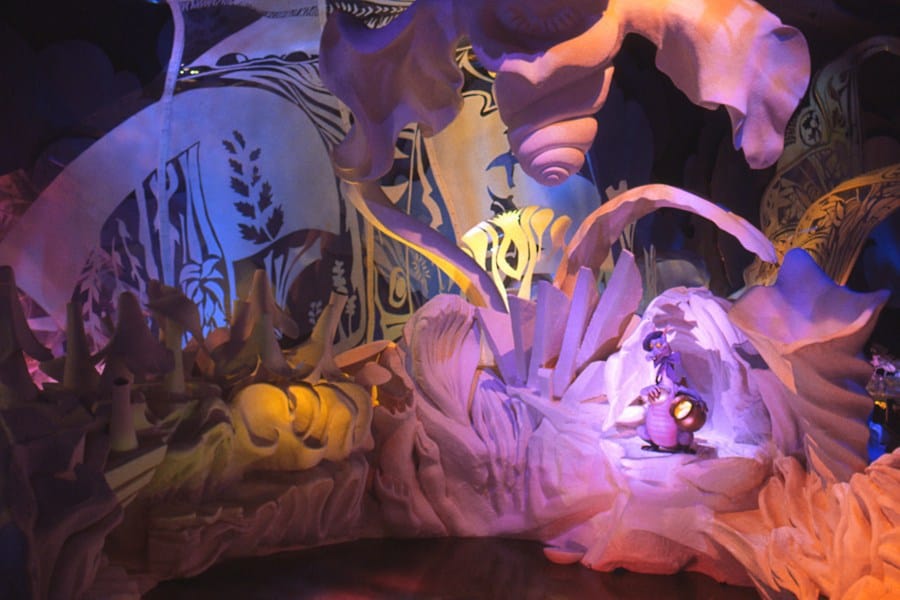
The painting would then come to life around guests with scenes that were no more than white props that had lights of all different colors hitting them. Some memorable pieces were the animal carousel, the small pond with the multicolor lily pads, painter Figment pouring his pot of paint into a rainbow, and the beautiful orchestral piece you would hear throughout the scene. The scene would end with thunderclouds bringing us into the scary stories.
The Dreamfinder was on a computer with an enlarged keyboard, typing a mystery/horror story under a giant letter A. The top of the A also looked like a volcano, spewing words from its vent. Those words flew across the top of the scene in different colors. The scene was also filled with large ominous letters. You would then pass Figment with letter blocks in his hand that spelled “cat,” with a projection of a cat and a full moon behind him. He would then flip the C block to a B, making it spell “bat,” and the cat projection would turn into a bat.
The next small room was filled with large words like “Shake” and “Sway,” with the word “Avalanche” over the next passage, appearing to fall on guests. Following that, there would be fireworks bursting in fiber optic form, spelling out “Sparkle” and “Flash.” The word “Surprise” would light up out of the dark, surprising guests, and a projection of the word “Genie” would actually change into a genie. You would then see Figment making a shadow puppet on a large page of a book actually somehow making the word “Shadow.”

There was a scene where gargoyles with illuminated eyes would stare at you, then guests would see a large screen with scary monsters all around a suspended animatronic Figment hiding in some kind of apparatus. There was then a big page that said “quoth the raven, nevermore” with the shadow of a window pane and a raven. One of the most famous parts of the scene was Figment trying to hold closed a book about monsters as they try to escape the pages.
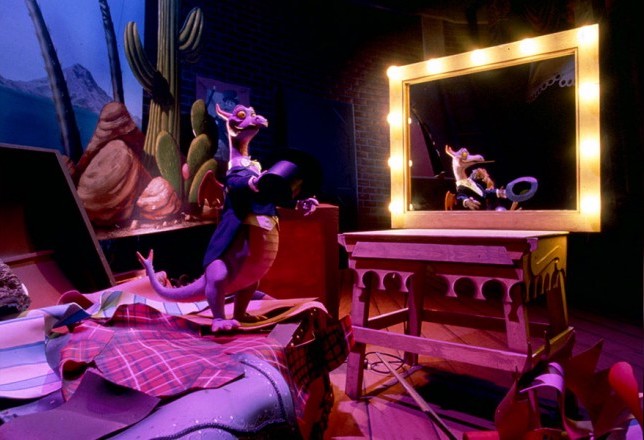
We then moved into the entertainment and show business scenes, kicked off by a premiere marquee with changing posters underneath it promoting Laughter, Music, Applause, and Dance among other things. On the left side, Figment was in his dressing room putting on a tuxedo and top hat with various sets behind him.

We proceeded into a laser show conducted by the Dreamfinder. Laser lights created top hats, canes, and musical notes, among other things. We were then greeted by the famous Spacesuit Figment, hitchhiking for a ride.
The transition into the science scene featured a large tunnel with illuminating rods and projections of different mathematical signs and equations. The circular science room had the Dreamfinder in front of a large globe, rotating a lever that showed scenes of photosynthesis, space travel, and other discoveries on screens on the opposite wall.
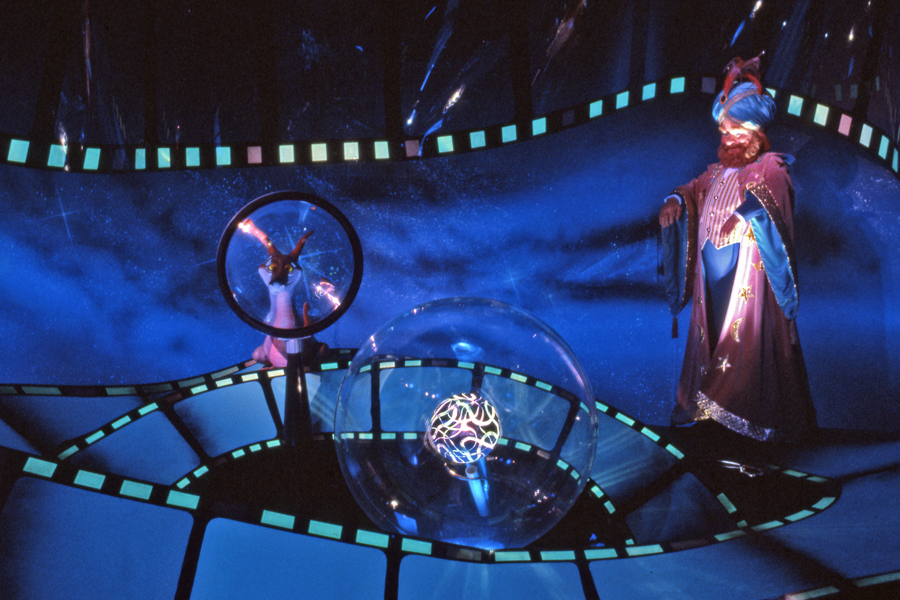
There was then a large circular screen above guests, featuring an animated Figment bouncing around, before a shutter closed the screen, giving us the idea that his picture was taken. At this point, some black-light signs pointed forward to “Destiny” and “Dreams.” Film reels began to appear as we saw the Dreamfinder in his “Carnac the Magnificent” outfit, explaining to Figment in his crystal ball that with the power of Imagination, he can do anything.
We then entered a huge Circle-Vision-style room, with Figment in the middle wearing his famous yellow sweater. The screens above had comedic scenes of Figment as a mountain climber, weightlifter, sailor, pirate, superhero, dancer, scientist, and cowboy.

The final scenes had the Dreamfinder behind a camera, seemingly filming guests as the picture taken before you entered the scene was shown on a screen next to him. You would then see a painting of Figment on the wall saying to follow him to the ImageWorks. Guests would then unload onto a speed ramp, which was deactivated and removed long before the rest of the ride.
Guests would exit into the other side of the lobby, where a few shelves of Figment merchandise would be.

Figment and Dreamfinder would also appear outside the attraction, in the ImageWorks, and as a walk-around meet-and-greet duo.
The End of Imagination
As part of the terms of the Kodak sponsorship, they were guaranteed a new attraction by the year 2000. Since the original attraction had a number of technical issues, it seemed that some major changes were needed. Also, every other original pavilion had undergone an update by this point, with Journey Into Imagination holding out the longest:
- Spaceship Earth – 1986 and 1994
- Communicore to Innoventions – 1994
- Universe of Energy – 1996
- Horizons – operated seasonally starting in 1993 and then closed permanently in 1999
- World of Motion – 1996
- The Land – 1993/94
Both Kodak and Disney wanted something modern, hip, and edgy, with Disney CEO Michael Eisner quite keen on removing Dreamfinder and Figment.
Since the 1994 opening of Honey, I Shrunk the Audience brought in the original concept of the Imagination Institute, they decided to carry over the story into the space next door. Even Dr. Nigel Channing (played by Eric Idle) would move over and become the host of the new attraction. Figment would be kept in a very small role to placate guests, but the Dreamfinder would cease to be.
In order to save money and avoid existing problems with the ride system, it was decided to eliminate troublesome parts of the track and just reuse the remaining track. The turntable scene was completely removed from the ride, with a floor put over most of it. The 80 ride vehicles were reduced to just 32, with the other 48 cars simply tossed away.
The load area would move inside the last leg of the turntable, while the unload area would now be about where the magician Dreamfinder was located. To compensate for the shorter ride track, three ride stops were added, so vehicles no longer moved continually.
Of the 60% of the original track used, the entire space would be gutted, Dreamfinder and all. This was also done to add storage space, more interior queue, and a smaller ImageWorks directly at the exit of the attraction instead of upstairs.
The original attraction closed on October 10, 1998.
Journey Into Your Imagination
Construction walls went up almost instantly around the attraction, with signs stating “Ride through a dazzling array of perceptual experiments! Take your imagination further October 1999”.
The original building color scheme was changed to oranges and reds, getting rid of the pleasant blues and purples. The pavilion’s name would also be changed to “Imagination!” and the large sign outside would now be a large circle featuring the Imagination Institute logo, and promoting the new ImageWorks, Honey, I shrunk the Audience, and Journey Into Your Imagination. The new pavilion was dedicated on September 29, 1999, as part of media festivities for the Millennium celebration at Epcot. The ride opened to all guests on October 1, 1999.
The banners just above the entrance had Journey Into Imagination in a futuristic font, with the word “Your” inserted with an arrow, appearing to be written in, an obvious play on the original name.

The queue now takes guests inside the Imagination Institute, passing through what appears to be an art deco-style office building, with small exhibits displaying some of the Institute’s history (Weebo from Flubber, a moving portrait of Nigel Channing where Figment appears and disappears,) as well as a reception desk and the doors of many offices. Department signs on the directory include Color, Dimension, Gravity, Illusion, Sound, and ImageWorks. We then pass a wall that has pictures of the Inventor of the Year award winners: Dr. Nigel Channing, Prof. Phillip Brainard from “Flubber,” and Wayne Salinski. Screens shaped like the Imagination Institute logo are above your head once you move past the office area, with Nigel Channing coming on to make notes, like how listening to Mozart music has been proved to make people smarter. Some offices you pass along the way belong to Wayne Salinski (you can hear the shrinking machine running), Prof. Phillip Brainard (with the shadows of Flubber characters passing the window), and Dr. Nigel Channing (whose phone is ringing off the hook). The hollow floor you walk over in the queue is actually covering most of the old turntable from the original attraction. A mural behind the vehicles featured the different labs guests would be visiting. The vehicles are the same in design as those from the previous attraction but no longer load continuously and are now in separate four-vehicle trains.
Guests were immediately whisked through the scanner and then shown in a mirror what’s in their imagination, which is revealed to be not much. Everything fades to black and guests were taken into Experiment #832: “See What You Hear”. In a pitch-black room, you began to hear train noises, as it felt like a train actually was passing right by the vehicles. It was then revealed that it was just sound and wind.
We then passed through some smaller-scale experiments, such as “Through the Looking Glass” — where guests were asked if the room was actually magnified by a giant magnifying glass — and “Shattering Assumptions” — where an anvil went through what looked like a glass table.
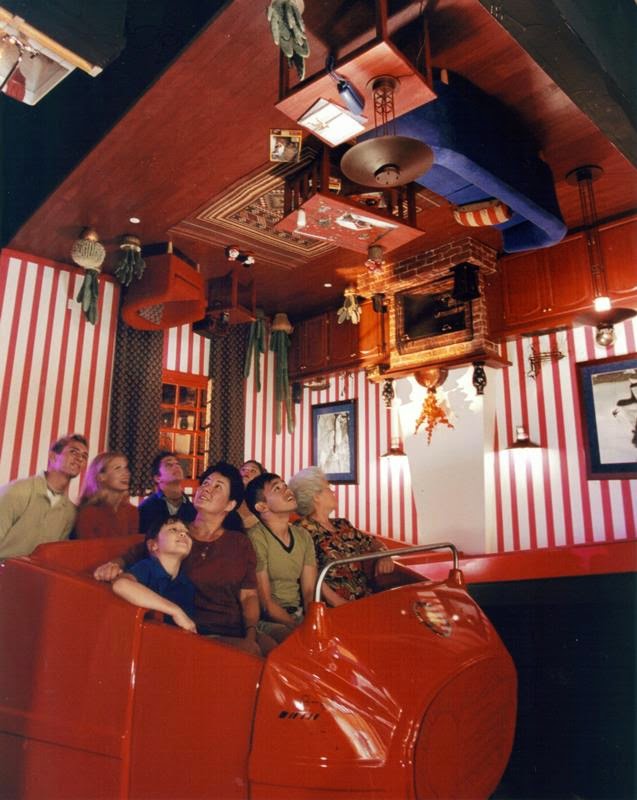
We then entered the Illusion Lab, where we were greeted by an empty cage that revealed a butterfly once we passed to the other side. We then went through the “Fish Out of Water” experiment, with a fish swimming through a bookshelf. We moved into the “Color of Sound” experiment, where two large light walls (screens) changed colors and intensity based on the sounds played. Guests were then battered with strobe lights as they entered the “Connections” experiment, which began with a board showing mathematical equations equaling infinite connections and a Figment made completely out of dots and lines. As the scene opened, guests were surrounded by illuminated lights with lines connecting them and creating images. Guests entered an upside-down house, where baths were filled, sinks dripped, and toilets flushed.
In the final test, guests passed through the scanner once again. This time in front of the glass windows, we pushed the scanner to the limit and it exploded to reveal a large screen filled with items and colors. Figment (now voiced by Corey Burton) made a short appearance on screen to tell us that we are “quite clever.” We then entered a starry room lit up to reveal the unloading area where you could then exit into the new ImageWorks – The “What If” Labs and a gift shop.
People Are Pissed
Guest relations and the company were bombarded with complaints about the new attraction, with guests depressed and furious over the removal of the original attraction and the Dreamfinder, as well as the minimized role of Figment. Guests were also just angry that the ride wasn’t very good.
Guests who had never experienced the original ride often called it “boring” or “a waste of time” in guest surveys. Almost immediately, Disney began to work on plans to change the ride, with almost zero financial help from Kodak.
The attraction quietly closed on October 8, 2001, just 24 months after it had re-opened. With a small budget of just under $10 million, the refurbishment began. At first, the banner at the front of the pavilion simply advertised ImageWorks and nothing else. The banner was then changed to say “something new is coming to Journey Into Imagination opening summer 2002” and featured Figment with a paintbrush. The sign would eventually be changed to the logo of the new attraction titled:
Journey Into Imagination with Figment

This attraction opened on June 2, 2002, with an altered story featuring the return of Figment (now voiced by Muppet performer Dave Goelz) and the “One Little Spark” theme. The attraction maintained the idea that guests were in the Imagination Institute and Eric Idle returned as Dr. Nigel Channing.

The queue remained mostly unchanged, with only the directory changed to reflect the new “Sensory Labs” we visit during our tour (Touch, Taste, Sight, Smell, Sound, and ImageWorks). Figment was added to the Institute logo-shaped screens and to the portrait of Dr. Channing on the award winners wall.

The wall behind the loading area now features billboards for all of the sensory labs, as well as a short quote from Dr. Nigel Channing. The loading experience is the same.

The track layout remains the same, but three more ride stops were introduced. After you pass through the “Sensory Labs” door, guest vehicles stop in the first scene, each car in front of one of four screens again shaped like the Imagination Institute logo. Each briefly shows logos for the labs we will be visiting: Smell lab, Sound lab, Touch lab, and Taste lab.

Nigel Channing then pops up on-screen and prepares us for the tour, but is almost instantly interrupted by Figment with a suitcase in hand. After a number of sight gags and being told he can’t come along, Figment goes out of sight and begins the tour.
As we make our way to the Sound lab, we pass an office door labeled “Dean Finder” a tribute to the Dreamfinder. We are played left ear and right ear tones (both notes of “One Little Spark”) to test our hearing. The doctor’s phone then rings, as he is being called by Figment, who pops out of a box in the Sound lab (wearing his famous yellow sweatshirt) and tries to teach us that we should listen with our imagination rather than our ears. As Channing loses his train of thought, Figment finds it, leading into the same train effect from the previous version of the attraction. As he does in every other scene after, Figment sings some new lyrics to the music from “One Little Spark.”
We then enter the Sight lab, with a screen projecting an eye chart. We see Figment sneaking around behind the letters before knocking them away and spelling out his name. We then get to “follow the bouncing Figment” and sing some more new lyrics to “One Little Spark.” After this, the caged Butterfly returns, this time appearing first, and then being set free as Figment gives the cue.

Guests enter the Smell Lab, passing by tubes containing different odors. We stop in front of a huge smell canister, where Figment appears and lets the good times roll. We win one scent, and Figment transforms into a skunk and sprays us with an unpleasant odor. After leaving this scene we pass three office doors for the Laugh Lab and the Dream Lab, before reaching a dead-end door leading to the touch and taste labs.

At this point, Dr. Channing changes his mind and ends the open house, leading Figment to take us to his own open house instead. With a flash of light, the next room goes black and a number of blacklight signs show the way to Figment’s upside-down house. Among the props inside are a Figment pick-up truck, Figment eating popcorn in front of a TV playing classic animated Figment clips, Figment taking a bubble bath, a Figment coffee pot, and Figment going through the fridge.

We then go on “Figment’s Commute to the Institute” as the dragon’s purple footsteps encircle the vehicle, going up and down the walls. This is also when the original theme kicks back in with Figment and Dr. Channing singing along. We enter a computer room at the institute where Dr. Channing appears and we learn that imagination works best when it’s set free.

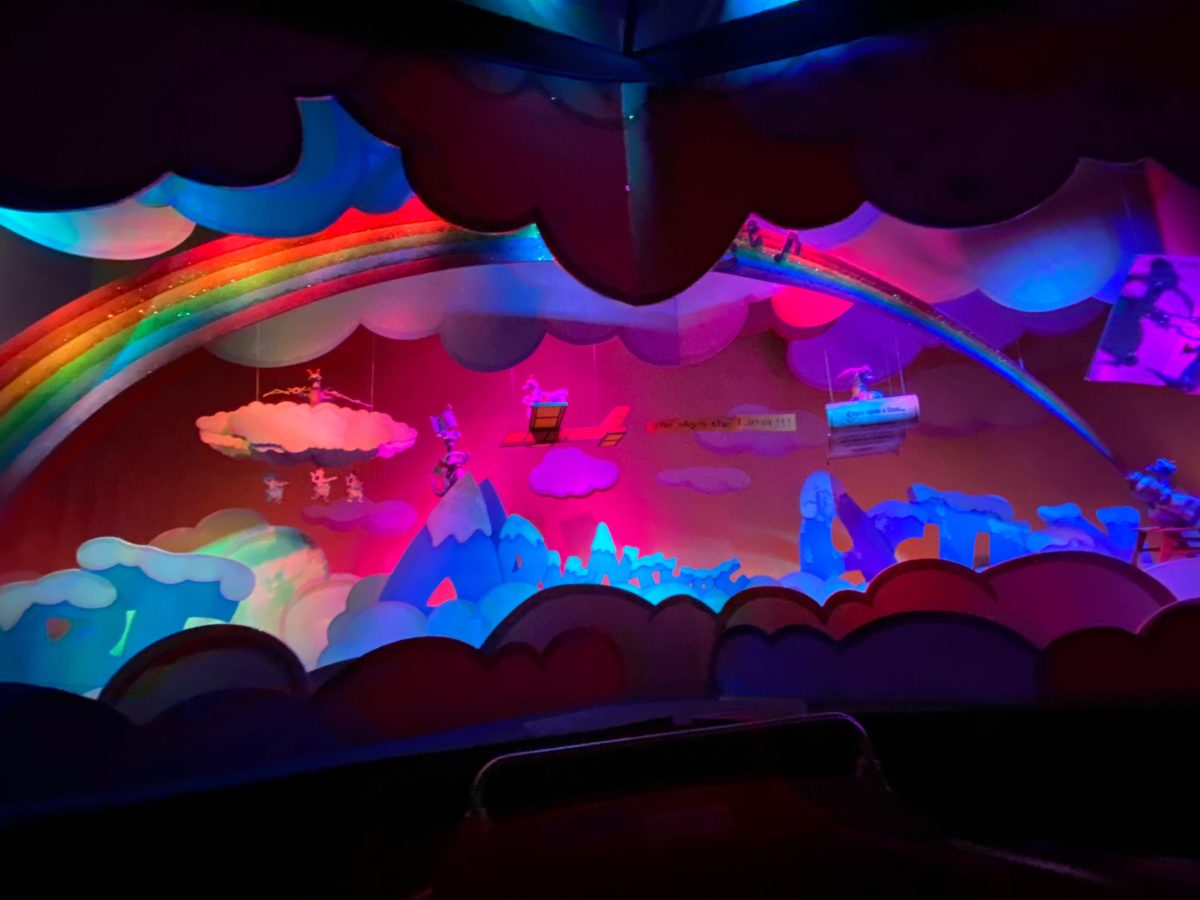
The screens and walls suddenly explode, revealing a scene with several Figments doing various activities. There is a Figment in a hot air balloon shaped like a light bulb, Figment as a painter shooting a rainbow that becomes Figment as the Mona Lisa, Figment hang-gliding on “One Little Spark” sheet music, Figment as a construction worker, mountain climber Figment, and puppeteer Figment with ballerina Figment puppets. The final “scene” is a starry room with a Figment spaceman hitchhiking under a Nigel Channing moon. The vehicles stop beyond the moon for unloading.
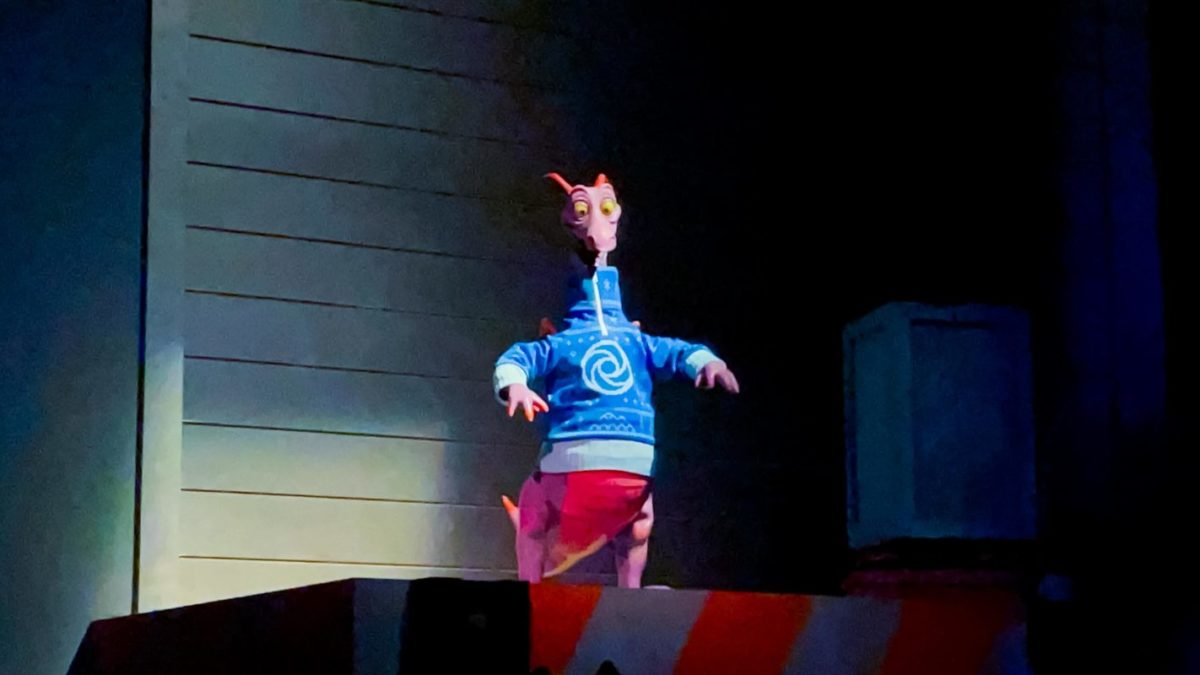
Beginning in 2020, two of the Figment audio-animatronics wear an EPCOT holiday sweater during the winter season.
Rumors of Removal
While Journey Into Imagination With Figment has been overall better accepted by guests, it has never felt like a permanent addition to the park. Within the first few years it existed, rumors that a new attraction was being developed began. Guests speculated that Dreamfinder would return in a new ride, but those rumors faded.
Leaked artwork showed a proposed makeover of the entire pavilion featuring Disney Channel’s “Phineas and Ferb” was pitched, although it is unclear how far that went into development. Nothing ever came to fruition.

As the major overhaul of EPCOT began, it was rumored that a new attraction in the space would feature characters from Disney-Pixar’s “Inside Out” alongside Figment, who was featured briefly in an Easter egg in the film. No ride change was ever announced, however. Joy from “Inside Out” does now meet guests in ImageWorks.
Beyond
In addition to “Inside Out,” Figment makes an Easter egg appearance in “Toy Story 4.”
The little dragon is featured on EPCOT merchandise to this day, and the Dreamfinder has made a few cameo appearances on holiday merchandise, MagicBands, and an EPCOT 40th anniversary pin.
A figure of Figment appears in the new Creations Shop at EPCOT and is dressed up for different festivals.
A “Figment” comic series inspired by the original version of the attraction and explaining the origin story of the Dreamfinder and Figment, ran under Marvel’s Disney Kingdoms imprint from May 19, 2014, to October 1, 2014. “Figment 2: Legacy of Imagination” ran from September 2015 to January 2016. Another sequel was planned but scrapped when the Disney Kingdoms imprint was shut down.

In January 2022, a Figment popcorn bucket was released during the EPCOT International Festival of the Arts. Guests waited in line for up to seven hours on the first day to get their Figment bucket. The popcorn bucket returned for the EPCOT International Festival of the Arts 2023 to much less fanfare.
The EPCOT International Festival of the Arts 2023 also featured a Figment-inspired spectacle of light show on Spaceship Earth with audio from the original Journey Into Imagination. There were Figment Magic Shots through Disney PhotoPass.
In September 2022, Deadline broke the news that Disney is developing a movie based on Figment. The movie will be produced by Seth Rogen’s Point Grey Pictures, with Dan Hernandez and Benji Samit (“Pokémon Detective Pikachu”) as writers.
A Figment meet-and-greet is set to return to EPCOT sometime in 2023.
For the latest Disney Parks news and info, follow WDW News Today on Twitter, Facebook, and Instagram.

love the trip down memory lane. thank you